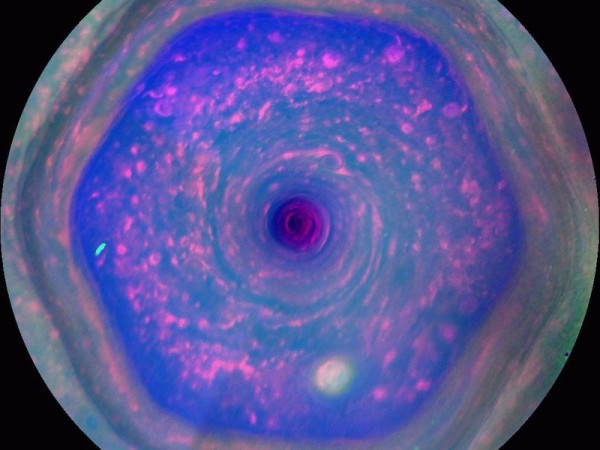By Ana Verayo, | October 26, 2016

This colorful view from NASA's Cassini mission is the highest-resolution view of the unique six-sided jet stream at Saturn's north pole known as "the hexagon."
New images from NASA's Cassini probe reveal that Saturn's strange hexagon shaped polar region is now changing color.
NASA's Saturn spacecraft Cassini captured new images of Saturn's polar region and its dynamic atmosphere. Past images revealed that the gas giant's north pole has been changing since 2012. Scientists are trying to figure out what brought about this drastic color change.
Like Us on Facebook
Mission scientists suggest that this color change was caused by the seasons of Saturn. The color changed from a bluish gray color to a pale yellowish one. Scientists say this hexagon-shaped polar region is probably caused by photochemical hazes in the atmosphere as the planet gets closer to the sun. Saturn is set to hit its summer solstice next May.
This bizarre hexagon is apparently a jet stream of haze that serves as a six-sided wall from particles outside to prevent them from entering this region.
Between November 1995 to August 2009, which is Saturn's winter season, the polar region became devoid of any aerosols that are generated by sunlight and its atmospheric chemical reactions.
However, when Saturn passed equinox or when springtime arrived in August 2009, the polar region's atmosphere was once again exposed to these photochemicals from the sun, changing the color of the north pole's hexagon.
Apart from this, scientists say that the circulation around the atmosphere is also crucial to this change. There is reportedly also a change in wind pattern once the hexagon is exposed to solar heat.
The first images of this strange polar hexagon of Saturn was obtained by NASA's Voyager 1 and 2 mission in the early 1980s. These images revealed that the hexagon was static, and not showing any signs of movement in direction or position on the planet.
However, scientists say that the clouds inside this hexagon was moving quickly in an enclosed jet stream as winds pull apart these streams at more than 250 miles per hour.
-
Use of Coronavirus Pandemic Drones Raises Privacy Concerns: Drones Spread Fear, Local Officials Say

-
Coronavirus Hampers The Delivery Of Lockheed Martin F-35 Stealth Fighters For 2020

-
Instagram Speeds Up Plans to Add Account Memorialization Feature Due to COVID-19 Deaths

-
NASA: Perseverance Plans to Bring 'Mars Rock' to Earth in 2031

-
600 Dead And 3,000 In The Hospital as Iranians Believed Drinking High-Concentrations of Alcohol Can Cure The Coronavirus

-
600 Dead And 3,000 In The Hospital as Iranians Believed Drinking High-Concentrations of Alcohol Can Cure The Coronavirus

-
COVID-19: Doctors, Nurses Use Virtual Reality to Learn New Skills in Treating Coronavirus Patients







